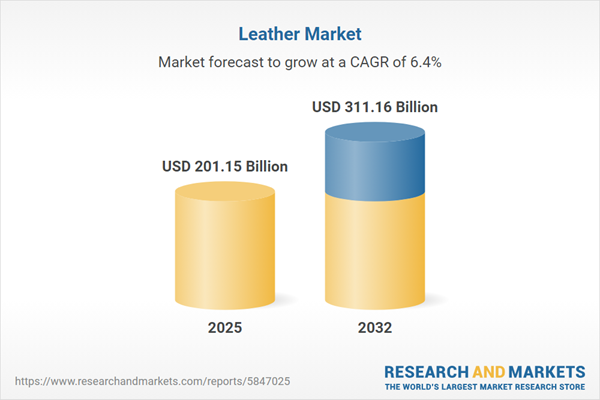Speak directly to the analyst to clarify any post sales queries you may have.
The global leather market is shifting rapidly as digital transformation, ethical sourcing priorities, and heightened compliance demands shape strategic decisions for senior executives. Adapting to these trends is central to maintaining operational resilience and capturing new sources of value in a changing landscape.
Market Snapshot: Global Leather Market Size and Growth
The global leather market reached a value of USD 188.96 billion in 2024 and is forecast to attain USD 201.15 billion by 2025, recording a compound annual growth rate (CAGR) of 6.43%. This expansion is driven by rising investment in digital manufacturing, a decisive pivot toward sustainable sourcing, and sustained demand across key industry sectors. Organizations integrating advanced technologies and prioritizing supply chain agility are positioning themselves for steady growth and quicker adaptation to evolving regulatory and market expectations.
Scope & Segmentation: Understanding the Global Leather Market
This research provides procurement, sourcing, and supply chain leaders with direct guidance on the primary segments shaping the industry’s direction:
- Leather Types: Evaluate full grain, split, and top grain leather alongside synthetic materials like polyurethane (PU) and polyvinyl chloride (PVC), supporting decisions on material portfolios to align with sustainability requirements and shifting buyer needs.
- Tanning Processes: Contrast chrome and vegetable-based tanning to assess operational efficiency, compliance, and environmental impact, providing critical data for selecting responsible production methodologies.
- Distribution Channels: Compare in-store retail with digital sales strategies, advancing omnichannel approaches that enhance market access and buyer engagement.
- Raw Materials: Examine sourcing practices across diverse hides—including bovine, alligator, ostrich, and small ruminants—to guide procurement teams through dynamic ethical sourcing and regulatory landscapes.
- Applications: Understand use in automotive, apparel, footwear, bags, accessories, and furnishings to support targeted product development and effective market entry for both B2B and B2C offerings.
- Regions: Assess conditions in the Americas, Europe, Middle East, Africa, and Asia-Pacific, ensuring leaders have access to region-specific insights on compliance, infrastructure, and buyer preferences.
- Leading Companies: Benchmark practices by studying the operations of Grasim Industries Limited, JBS S.A., Minerva S.A., TFL Ledertechnik GmbH, Pittards plc, Welspun Syntex Limited, Pacific Coast Leather, Inc., Shandong Limed Leather Co., Ltd., Assodivers S.r.l., and Kerry Group plc.
Key Takeaways for Senior Decision-Makers
- Integrating digital supply chain tracking with established industry craftsmanship sharpens traceability and transparency, supporting robust responses to regulatory and stakeholder scrutiny.
- Implementing sustainable tanning and recycled materials in procurement strategies strengthens supply chain resilience and aligns operations with shifting environmental priorities.
- Developing a diverse supplier base makes organizations more adaptable to changing market dynamics and complex compliance requirements across geographies.
- Adopting omnichannel sales models fosters flexible inventory management, broadens customer reach, and enables new regional and global expansion pathways.
- Pursuing certification and traceability programs reduces compliance risks and supports alignment with international and regional standards as they evolve.
Tariff Impact Across the Leather Supply Chain
Recent US tariff changes have increased operational costs throughout the leather supply chain. In response, organizations must reevaluate sourcing and procurement strategies by reinforcing supplier networks. Those who proactively cultivate adaptable sourcing relationships are better positioned to reduce trade-driven cost fluctuations and sustain business continuity, even as trade conditions remain uncertain.
Methodology & Data Sources
Findings in this leather market research are derived from direct interviews with industry specialists and procurement professionals. Data reliability is ensured through extensive cross-verification with regulatory documentation, sustainability metrics, and real-world case studies. The research methodology supports accurate, actionable strategic planning for executives.
Why This Report Matters to the Global Leather Market
- Enables leaders to future-proof supply chains and operations by aligning with emerging technologies and rigorous environmental standards.
- Offers actionable segmentation and regional analysis, empowering firms to drive strategic agility and informed enterprise decisions within complex global markets.
- Clarifies value chain exposures to strengthen risk management, ensuring systematic compliance and supporting resilient growth strategies.
Conclusion
This report equips senior decision-makers to promote sustainable innovation, embrace digital transformation, and build flexible supply chains that address the evolving requirements of the global leather market.
Additional Product Information:
- Purchase of this report includes 1 year online access with quarterly updates.
- This report can be updated on request. Please contact our Customer Experience team using the Ask a Question widget on our website.
Table of Contents
3. Executive Summary
4. Market Overview
7. Cumulative Impact of Artificial Intelligence 2025
Companies Mentioned
The companies profiled in this Leather market report include:- Grasim Industries Limited
- JBS S.A.
- Minerva S.A.
- TFL Ledertechnik GmbH
- Pittards plc
- Welspun Syntex Limited
- Pacific Coast Leather, Inc.
- Shandong Limed Leather Co., Ltd.
- Assodivers S.r.l.
- Kerry Group plc
Table Information
| Report Attribute | Details |
|---|---|
| No. of Pages | 180 |
| Published | October 2025 |
| Forecast Period | 2025 - 2032 |
| Estimated Market Value ( USD | $ 201.15 Billion |
| Forecasted Market Value ( USD | $ 311.16 Billion |
| Compound Annual Growth Rate | 6.4% |
| Regions Covered | Global |
| No. of Companies Mentioned | 11 |









